Key Insights
- Syscoin is an open-source and decentralized development platform that aims to combine the security of Bitcoin’s PoW and programmability of Ethereum’s EVM. Its modularity allows it to support EVM rollups and other Layer-2 scaling technologies.
- The growth of Syscoin’s user base and ecosystem primarily takes place on an L2 called Rollux, which was deployed to mainnet on June 28, 2023. The Syscoin L1 itself serves as the infrastructure, with SYS also serving as the native coin of Rollux.
- Syscoin L1 utilizes merge-mining as it aims to give L2s the security of Bitcoin’s own network.
- Rollux is an Optimism fork built to be fast and low-cost enough for microtransactions, yet secured from beneath in such a way as to support high-value use cases.
- Rollux uses Syscoin’s general-purpose data availability solution called Proof-of-Data Availability (PoDA) to link to Syscoin L1, which is supported by Bitcoin miners.
- Through the use of zero-knowledge proofs and a ZK-based light client for SYS, zkDA was established with the goal of extending PoDA to other chains.
Introduction
Blockchain scaling solutions have been some of crypto’s most popular ecosystems. There has been a constant battle to bring efficient throughput, cheap transaction fees, and speed amongst protocols, even during market downtrends. Last year alone, scaling solutions and new Proof-of-Stake (PoS) chains have raised over $2 billion in private funding.
Syscoin is notable for its evolution over the past nine years. It was the first protocol to combine Bitcoin’s Proof-of-Work network with the flexibility of EVM-equivalence within a modular architecture that fully supports rollups with a native data availability protocol. Syscoin’s goal is to provide decentralized technology and infrastructure that can scale to future demands in mass adoption scenarios. In January 2024, it took significant steps forward to the end, launching zero-knowledge data availability (zkDA) functionality to extend its offering to other blockchains and rollups
The project has completed both the base-layer infrastructure and the deployment of a scalable L2 called Rollux. This layer already shows a growing ecosystem of DeFi protocols, tools, and applications. Enterprises such as SYS Labs are focused on launching new applications and products designed to leverage Rollux and additional fractal scaling or application layers on top of Syscoin.
Background
Syscoin mainnet launched in 2014 as a fork of Litecoin. It aimed to enhance the capabilities of a traditional PoW chain by enabling features like “aliases” (decentralized identity), “certificates” (NFTs), and a working onchain decentralized marketplace. Dan Wasyluk and Sebastian Schepis initially led the project.
In 2015, Lead Core Developer and now Foundation President Jagdeep Sidhu joined the project. He shifted the project’s primary focus toward solving the bigger challenge of blockchain scalability rather than offering hardcoded smart contracts that would inevitably hit limits. Syscoin has been supported by the Syscoin Foundation, an organization created in 2016 by Syscoin’s core team, which includes Jagdeep Sidhu and Willy Ko.
The project had a public token sale in 2014, selling 15% of the initial token supply for over 1,500 BTC, worth around $300,000 at the time. However, the BTC raised during the sale was stolen by the escrow agent, Ryan Kennedy, the former CEO of the cryptocurrency exchange Moolah. The funds were not recovered. Despite this obstacle, the project team continued developing Syscoin and successfully delivered the product reflected in its initial proposal.
Syscoin progressed by revamping its platform and product offerings by developing Syscoin 2.0 and 3.0 between 2017 and 2019. Within that period, the team introduced various technical updates, such as transitioning the network’s Scrypt-based chain to SHA-256 with merged mining, integrating customized Sentry nodes, and developing the Zero-confirmation Directed Acyclic Graph (Z-DAG) scalability upgrade.
In May 2019, the Syscoin project team announced the launch of the Syscoin 4.0 mainnet which would include a number of upgrades including Taproot. These events led up to the introduction of Syscoin’s Network-Enhanced Virtual Machine (NEVM), brought live to mainnet on Dec. 6, 2021, in version 4.3. Immediately afterwards, Syscoin Foundation began focusing on the next steps: enshrining data availability within the Syscoin protocol.
Once the coding of Proof of Data Availability (PoDA) began in 2022, SYS Labs was formed and was eventually registered in the UAE. The new enterprise began coordinating with Syscoin Foundation to develop the ecosystem’s first rollup. The rollup became known as Rollux and would be based on Optimism yet with additional functionality enabling it to run on top of Syscoin and to leverage PoDA. On March 13, 2023, Syscoin Foundation announced the mainnet release of PoDA. Shortly after, the final testnet deployment of Rollux was announced, followed by the mainnet release on June 28, 2023.
Technology
Network Architecture
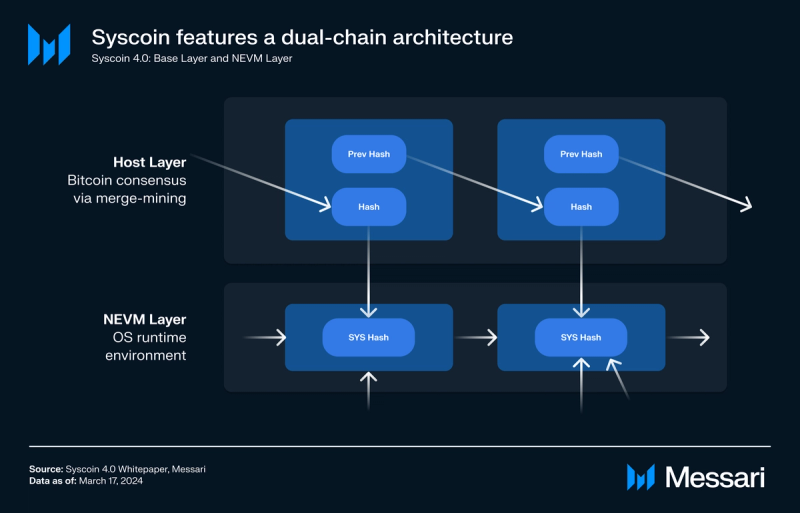
The Syscoin L1 is a dual-chain architecture, featuring a PoW base chain and an EVM-compatible chain (NEVM), which are integrated within the Syscoin protocol. The foundational chain is UTXO-based like Bitcoin and runs on a merge-mined consensus mechanism, tying its security to Bitcoin. The NEVM chain provides EVM-compatible execution, such as smart contract deployment and interoperability with other EVM networks.
Base Chain (UTXO)
The base chain houses Syscoin’s merge-mined PoW layer. The Syscoin network can leverage hashpower from Bitcoin’s own network through the process known as merged mining. Merged mining allows miners to mine multiple blockchains simultaneously via Auxillary Proof-of-Work (AuxPoW). For Syscoin, the Bitcoin chain acts as the “parent chain” to a miner and allocates hashpower, while Syscoin performs the role of the “auxiliary chain.” Therefore, by aligning its algorithm with Bitcoin’s (SHA-256), Syscoin can utilize Bitcoin miners’ hash power. Currently, over 50% of the Bitcoin mining hash power is used to mine Syscoin blocks, as can be seen by comparing the Bitcoin and Syscoin hashrate charts. Miners on the base chain interact with the Operating System layer or NEVM by publishing completed Syscoin blocks to the NEVM.
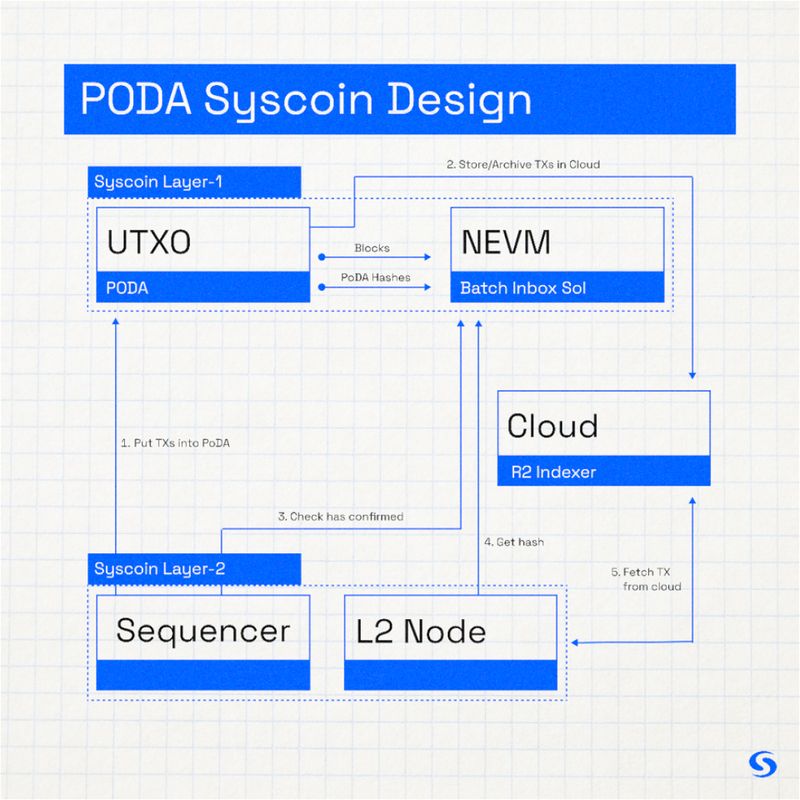
Source: Syscoin Docs
As of March 23, 2023, the Syscoin base chain also provides a native data availability protocol and associated fee market called Proof of Data Availability (PoDA). PoDA is designed to support any kind of rollup, including optimistic and ZK-based ones, and it can be used by both EVM and non-EVM systems. While PoDA serves the same basic purpose as Ethereum’s proto-danksharding (EIP-4844), it differs in regards to how data is stored, presented, and pruned, as well as in how fees are calculated. For example, PoDA uses Keccak cryptography instead of KZG polynomial commitments required in Ethereum’s danksharding design.
Additionally, unlike a traditional UTXO network such as Bitcoin, users can mint fungible and non-fungible Syscoin Platform Tokens (SPTs) on the Syscoin base chain, which are UTXO-based tokens. The base chain also includes Taproot functionality identical to that of Bitcoin, and as such, Bitcoin-style ordinals can be created and transferred.
Operating System Chain
Syscoin NEVM is an Ethereum Virtual Machine (EVM) chain where smart contracts can be created and deployed. NEVM works in sync with Syscoin’s base chain layer. This is achieved by pushing the tip hash generated on the NEVM into Syscoin’s base chain blocks. Users on NEVM can mint EVM-compatible tokens, execute smart contracts, and bridge to the ecosystem’s L2 EVM rollup, Rollux. Any token standards supported by Ethereum are also supported by NEVM (ERC-20, 721, 1155, etc.).
The NEVM relies on the PoW base chain for consensus and settlement. Block hashes from the NEVM are included in base chain blocks. By interlinking these chains, Syscoin provides a single Layer-1 that leverages traditional PoW network security and Ethereum’s smart contract capability. Of note, SYS is the native coin of both chains, and its supply can be automatically bridged between both chains by users via a mechanism that uses SPV proofs to mint/burn.
Rollux: A Rollup for Scalable Execution by Applications
Having delivered on its modular tech stack roadmap (including the data availability protocol discussed later in this report, and the Rollux L2), Syscoin Foundation, aided by SYS Labs, is now focused on supporting and expanding its L2 ecosystem. It’s also seeking to participate in joint research and development on ZK-based solutions involving light clients, cross-chain technologies, and application-specific rollups that include non-EVM runtimes.
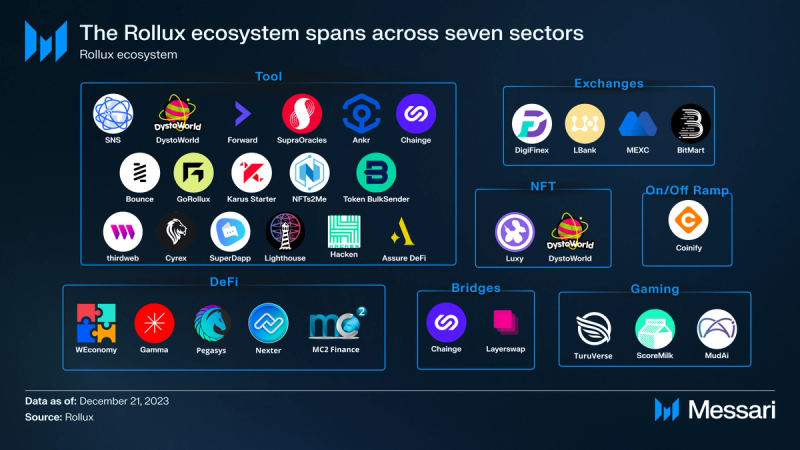
So far, Syscoin has faced challenges with user and developer adoption due to the slower speed of its security-focused Layer-1 and the lack of an available Layer-2. Regardless, the team has stuck to its modular design principles and has since deployed the Rollux L2. Rollux now features an emerging ecosystem of applications and protocols that could make SYS competitive. SYS Labs, an enterprise, is developing several products in addition to Rollux that will be deployed within the ecosystem, in addition to independent onboarding and integrations now seen within the ecosystem.
Consensus Mechanism
Participants
Miners
Miners participate in merged mining with Bitcoin, which provides Syscoin’s security and base-chain consensus mechanism. Miners interact with the Operating System layer or NEVM by publishing completed Syscoin blocks to the network and are rewarded in SYS.
Sentry Nodes
Syscoin Sentry Nodes are incentivized full nodes for both the base and NEVM chains, operating on the same machine and providing a second layer of services to the network. Apart from recording and hosting full copies of the network’s state, Syscoin Sentry nodes provide a decentralized means of finality through multi-quorum chainlocks via BLS signatures. The Syscoin team intentionally designed this structure to stay true to their core belief in PoW blockchains. Rather than relegating back to a pure PoS system, Syscoin uses these nodes for finality through a carefully thought-out process of chainlocks.
Syscoin’s finality is an additive security on top of the Nakamoto PoW consensus. It makes merged mining safer by creating resistance, yet the chain and network will also continue in its absence. Unlike Dash and many other networks that utilize masternodes, Syscoin’s Sentry nodes do not serve as a subset of trusted validators. Instead, Syscoin’s network prioritizes decentralization by maintaining the same approach as Bitcoin, where all full nodes verify before trusting. Aside from participating in finality quorums and decentralized governance, Syscoin Sentry nodes serve the same role as any standard full node.
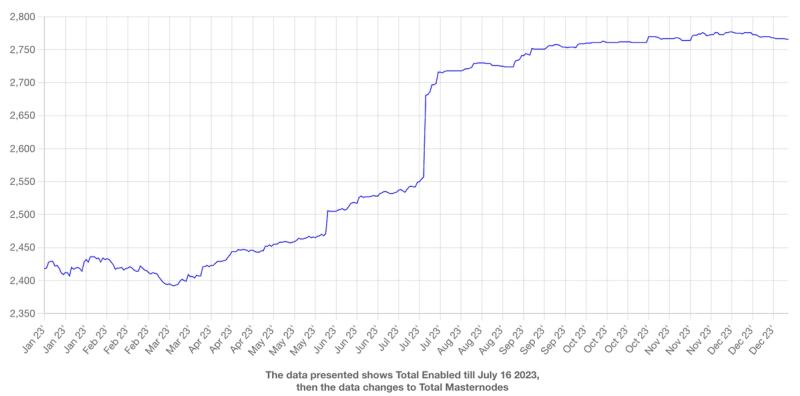
Source: Sysnode.info
Sentry nodes need to stake 100,000 SYS to participate in supporting network functionality. It should be noted that the collateral required to operate a Sentry node stays in the owner’s self-custody, and it can be unstaked at any time and moved to a new address by its owner. However, moving it eliminates the seniority Sentry node owners earn. Seniority incentivizes Sentry node operators to keep their nodes running and their collateral in place by rewarding additional SYS. The rewards are doled out first after one year and then reach full maturity after 2.5 years, which brings a 100% bonus over the base rewards. Currently, nearly half of Syscoin’s ~2,700 Sentry nodes are operating at full maturity (over 2.5 years). Hardware requirements for setting up a Syscoin Sentry node can be found here. APR and other income-focused metrics can be found here.
Mechanism
The Syscoin base layer inherits Bitcoin’s own security via merged mining. Merged mining was proposed by Satoshi Nakamoto and made part of Bitcoin Core in 2010. It enables Bitcoin miners to mine multiple cryptocurrencies by simultaneously providing their hash power to numerous blockchains, without incurring additional energy expenses beyond what they already spend to support Bitcoin. At the time of this research, Syscoin is inheriting around 60% of Bitcoin’s own hashrate, as seen by comparing the ratio of hashrates of Bitcoin and Syscoin.
By providing its own native EIP1559-based utility coin (SYS) to Bitcoin miners, Syscoin incentivizes them to continue supporting Bitcoin in the face of Bitcoin’s diminishing block rewards and static fees. SYS has similar utility-focused economics as ETH, thus it does not intrude upon BTC’s economics.
In effect, merged mining allows miners to mine multiple blockchains simultaneously via Auxiliary Proof-of-Work (AuxPoW). SHA-256-compliant projects such as Rootstock and Namecoin utilize merged mining with the Bitcoin network. Furthermore, any PoW blockchain can utilize merge-mining, with one example being Dogecoin merge-mined with Litecoin. AuxPoW incorporates a “parent chain” that allocates hashpower to auxiliary chains. An added benefit of this approach is that merge-mining does not require additional mining resources, making it effectively the only carbon-neutral form of PoW.
In Syscoin’s case, Bitcoin acts as the “parent chain.” As such, Bitcoin miners can choose to allocate hashpower to Syscoin’s PoW chain and mine both Bitcoin and Syscoin simultaneously without committing additional resources.
Multi-Quorum Finality
Since the number of miners participating in mining SYS is smaller than Bitcoin’s entire network of miners, the possibility of a 51% attack increases. In a 51% network attack, malicious miners can control which blocks will be mined, interrupting the network and preventing honest miners from completing new blocks. Therefore, Syscoin leverages chainlocks, a mechanism first introduced by Dash, to increase its security. Syscoin’s particular implementation of chainlocks relies on multiple Long Living Masternode Quorums (LLMQs) that decide on the next block to be mined. Thereby providing a second layer of verifying the correct order of block mining, Syscoin greatly mitigates the risk of a successful 51% attack, given that finality prevents selfish mining concerns. Miners would only be able to selfishly mine within the finality window (5 blocks), or else they’d be forced to restart their work and compete with the other Bitcoin miners on the Bitcoin network to mine 5 blocks before anyone else can mine 1 block).
These chainlocks are established at a relatively high degree of Nakamoto coefficient. The mechanism involves four separate quorums, each consisting of 400 randomly selected Sentry nodes (1,600 in total), which are reformed periodically. This same mechanism also serves to provide finality for smart contracts on NEVM and the Rollux L2. In order for a 51% attacker to succeed, they would have to control over 50% of the portion of Bitcoin’s hashrate supporting Syscoin and control a supermajority (60%+) of Syscoin Sentry nodes. Due to the validators and finality, there is an additional risk of halting a chain by voting on invalid block headers. But, Syscoin averts this problem by allowing this condition to have finality fall back to the previous chainlock in said scenario.
This finality is a core component of the ZK light client for Syscoin’s zkDA. It will enable Syscoin to validate the DA’s existence and prevent the SYS chain from rolling back from its DA inclusion. This feature will allow optimistic rollups to be incorporated, given that they require determinism to be included.
Scaling Features
Base Chain Scaling: Z-DAG
Before launching the NEVM chain, the Syscoin team aimed to add transaction scaling features to its base chain PoW layer. One of these features was Zero-confirmation Directed Acyclic Graph or Z-DAG. Z-DAG is a throughput scalability solution created by Syscoin’s Lead Developer, Jag Sidhu. It is used to support asset transactions on Syscoin’s base UTXO chain. Syscoin engineered Z-DAG as a redundancy protocol to the existing transaction settlement mechanism provided by PoW. This allows transactions broadcasted to the network to be relayed to their destination before requiring verification, providing peer-to-peer “fast transactions” or “micro transactions” of SPTs, including the native token, SYS, on the Syscoin base chain. Z-DAG aims to become a viable option for scaling simple value transactions, given that it can exceed the throughput of major credit card processors like Visa and MasterCard.
Syscoin Bridge
The Syscoin bridge operates as a two-way mechanism between its native blockchain and the NEVM platform that utilizes Syscoin Platform Tokens (SPT) as intermediaries. The process begins by burning of SYS tokens on the native blockchain and then issuing an equivalent amount of SYSX (SPT) tokens. These SYSX tokens are then locked within the bridge’s infrastructure to prevent double-spending. Next, the same amount in SYS tokens in ERC-20 format is minted on the NEVM.
The same process works in reverse: burning the SYS ERC-20 tokens on the NEVM, unlocking the equivalent amount of SYSX on the Syscoin blockchain, and restoring the SYS tokens on the Syscoin network. This structure aims to maintain a constant total supply of SYS across both blockchains and to tap into Ethereum’s ecosystem.
Of note, the team has stated that SPT tokens could also be bridged to the NEVM via the Syscoin bridge. However, users must refer to Syscoin bridge contracts to enable specific bridging of non-SYS tokens. According to the documentation, the bridge is a “non-custodial” implementation where a bridge operator does not manage tokens during the process.
Tokenomics
SYS Utility and Features
Syscoin’s native utility token, SYS, is used for payments, gas fees, and network security (Sentry node staking and miner block rewards).
SYS Distribution
Upon launch of the network’s mainnet in 2014, SYS initially had a max supply of 2 billion tokens. More recently in 2021, the SYS supply has since been updated with the integration of EIP-1559, is currently uncapped, and is estimated to have an inflationary rate of 1.25% per year. The breakdown of the token’s distribution will take into account the current state of the SYS supply:
- Initial distribution: A total of 364 million SYS was mined and distributed upon the mainnet deployment of Syscoin V1 on August 17, 2014, primarily to pre-sale participants. At that time, with SYS max supply capped at 2 billion, this represented 18% of the max supply. In terms of today’s circulating supply it represents 48%. Based upon the average pre-sale purchase price of SYS at ~490 satoshis (0.0000049 BTC) with Bitcoin trading around $510 USD, the total value of the distribution is estimated at ~$910k USD. Allocations were as follows (with estimated value):
- Public token sale: 304,222,858 SYS ($760,252 USD)
- Development, marketing, and operations: 40 million SYS ($99,960 USD)
- Bounties and rewards: 20 million SYS ($49,980 USD)
- Base chain block rewards: At launch, 96.25 SYS was minted for each base chain block, with that amount decreasing by 5% yearly and an additional yearly reward halving. Notably, 90% of base chain block rewards go to consensus participants. Of the 90%, 25% go to miners, and 75% go to Sentry nodes. The remaining 10% is allocated towards decentralized governance that functions the same as Dash governance. Governance funds are emitted in monthly superblocks to fund proposals ratified by Sentry node voters. Superblock funding similarly diminishes over time and details can be seen here.
- NEVM block rewards: Only miners participating in merged mining and contributing to the Syscoin base chain layer can earn NEVM block rewards. NEVM block rewards are emitted at a constant rate of 10.55 SYS per block processed on the NEVM layer. Of note, NEVM block rewards are generated on the NEVM chain.
- Transaction fees: Transaction fees across the base chain and NEVM are sent to miners and Sentry node operators in a 50/50 split. Of note, the project team has implemented EIP-1559, introduced by Ethereum in 2019, which enforces a fee-burning mechanism for gas fees paid by users and/or smart contract deployments.
Just prior to the release of NEVM, in October 2021, the Syscoin Foundation proposed a Treasury Fund to governance participants. After the proposal passed, 100 million SYS tokens (~14.8% of the total circulating supply at that time) were minted. They have been allocated to fund the continued development of the Syscoin network at the Syscoin Foundation’s discretion. A breakdown of the treasury allocations includes:
- 65 million SYS (~9.7% of the total circulating supply) has been allocated towards general core team funding and project onboarding/integrations.
- 35 million SYS (~5.2% of the total circulating supply) has been allocated towards future VC/private funding rounds.
Network Activity
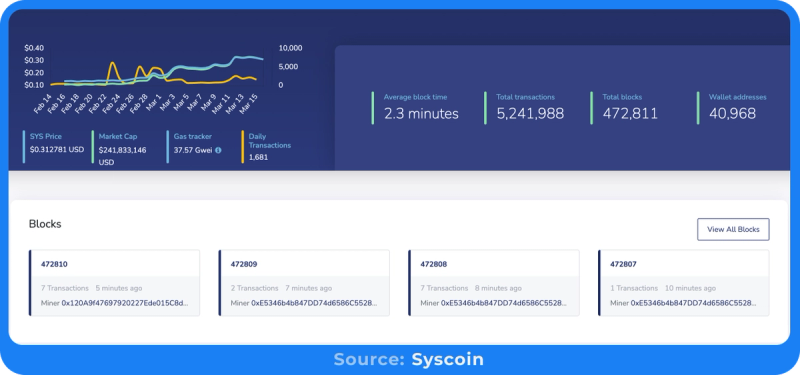
In terms of network activity, Syscoin still has a significant road to cover compared to its peers. Active wallets on the Syscoin NEVM total just over 40,000, and over 200 tokens have been launched/created on the network. To give a frame of reference, Ethereum has over 219 million wallets. Syscoin’s L2, Rollux has seen more network activity, averaging over 50,000 daily transactions in the last month.
The Road Ahead
Growth Strategies
According to the Syscoin 4.0 Whitepaper, one of Syscoin’s main focuses is developing more scaling solutions. Syscoin has gone through multiple technical upgrades and iterations over the years. Although the project has been heavily focused on developing its underlying tech stack, integrating the NEVM and future scaling upgrades (PoDA and rollups) indicates a new step in the protocol’s evolution.
The Syscoin 4.0 Whitepaper also describes the integration of SDK and Application Layers. The SDK layer supports scalability solutions such as ZK-rollups for the NEVM and an Application Layer allowing applications to be built on the SDK Layer. With these additions, the team has increased transaction speed, lowered costs, and increased scalability for users and developers. As of today, the project has adopted Rollux as the network’s first rollup on the SDK layer. Rollux is a scaling solution based on a fork of the Optimism network refactored to utilize Syscoin’s PoDA protocol. It is currently live on mainnet.
Below is the four-layer tech stack for Syscoin per the Syscoin 4.0 Whitepaper
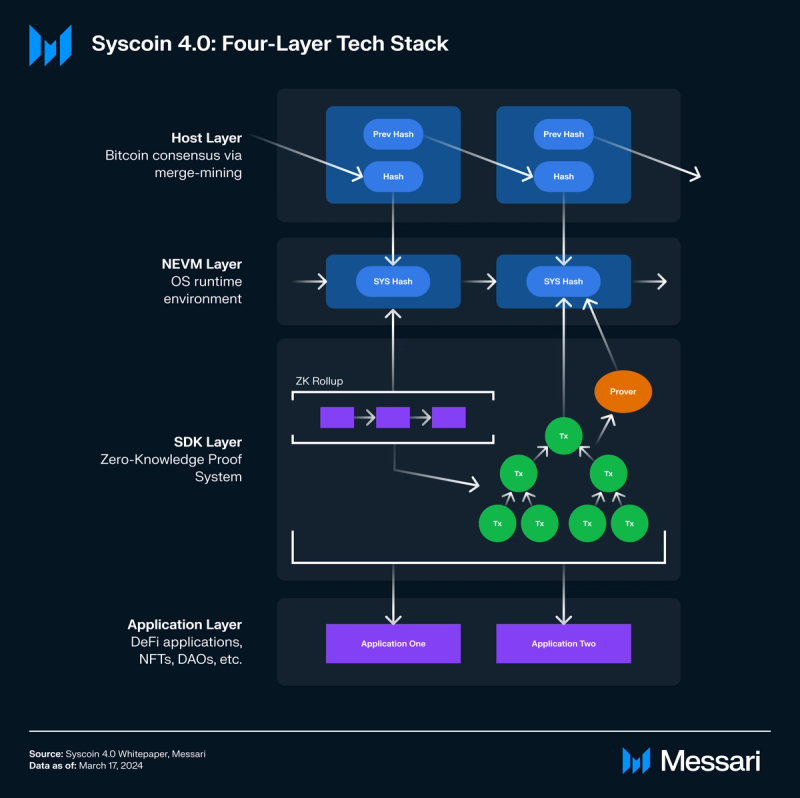
Additionally, the team announced the release of a dedicated data availability protocol named PoDA (Proof of Data Availability) for securing the SDK layer. Data availability allows nodes on a network to gain access to data contained within all rollup or L2 blocks. This, in turn, mitigates potential security risks if a block producer for a rollup or other L2 refuses to make transaction data available which would compromise the integrity of the data verified by nodes. Data availability services typically aim to operate with the same security assumptions as the L1 chain where rollup users would move their funds if they were to exit the rollup. Syscoin’s PoDA directly fulfills this demand. Also, Rollux gains this benefit at a low cost rather than turning to third-party data availability providers to cut costs. Doing so mitigates the risk of extra security assumptions that reside outside the domain of the L1. Like Rollux, rollups that use Syscoin as their L1 through PoDA would also gain this benefit.
Protocols such as Celestia aim to provide data availability to other chains. With Syscoin’s recent zkDA launch, it has staked its offering on an in-house data availability layer rather than relying on third-party ones. With this, the team has introduced the ability for further throughput scalability to its rollup-centric SDK layer. This DA is also designed to serve L3s and other successive application layers, or “fractal layers,” that are built on top of the Rollux L2.
Ultimately, the team aims to have Syscoin serve as the go-to, BTC-secured DA layer for other chains. As such, Syscoin has been developing a BTC-based mechanism similar to re-staking. It aims to give crypto-economic security to the Bitcoin L2 community and others, akin to what Eigen Layer provides to the Ethereum community. These features might appeal to emerging Bitcoin L2 projects, which currently depend upon third-party DA and various MPC/multi-signature agreements for bridging BTC. Additionally, Syscoin’s offerings could appeal to projects seeking the security and resilience guarantees of Bitcoin’s PoW rather than relying solely on PoS systems. While promising, it should be noted that these features are still under development.
The project team also plans on promoting a user and developer-friendly environment, attracting more applications, traffic, and TVL to its network. The team states that in the near future they will execute a multi-pronged strategy that includes social-driven advertising, hackathons, and other events, as well as point-based campaigns. The end goal is to promote activity and TVL associated with SYS Labs’ several oncoming DeFi protocols, applications, and offerings. The Syscoin Foundation treasury is also used to foster the ecosystem and increase the number of projects onboarding to the network. Ultimately, the aim is for these projects to gain independent funding, in the same way that SuperDapp managed to recently.
They also hope to implement their DAOSYS DeFi framework, providing an autonomous service engine to help developers create their own treasuries/DAOs to fund projects. It uses a concept roughly similar to Alchemix’s “self-repaying loans” but more focused on ecosystem growth.
The same new DeFi primitive in DAOSYS, which SYS Labs coins as ”liquidity trees,” is expected to have a separate implementation in a SYS Labs product called Pachira. The end goal is to introduce more capital efficiency for liquidity pool providers as well as cross-chain functionality. Liquidity trees could even be complementary to Uniswap V3 and other CLMM liquidity pool protocols.
Potential Risks and Roadblocks
Syscoin still has a long way to go in terms of developer and user adoption compared to larger L1 networks. In its current state, Syscoin has some risks to consider, including its use of merged mining, its reward structure, and its lagging participation rate.
With its newly launched zkDA capabilities, Syscoin could face analogous perils to what bridges have repeatedly faced over the years. A keen analysis of the risks associated with bridges and interoperability will be instrumental in safeguarding the network as it expands to become the premium BTC-secured DA layer for other chains.
Per the Syscoin 4.0 Whitepaper tokenomics section, the project team has projected that rewards for miners participating in merged mining will reach near zero due to the rewards’ deflationary nature. While rewards will never be fully eliminated, potential vulnerabilities to the network may arise with the reduction in miner incentives and, consequently, participation in maintaining the network’s security, as seen in other PoW blockchains.
Despite Syscoin’s ongoing network infrastructure developments, it has struggled to attract significant participation rate in developer onboarding, transaction volume, and user activity. An increase in transaction volume and developer activity on the network may introduce more incentivization methods for miners and Sentry nodes as the network evolves. To potentially raise those incentives in the future, the project must address the onboarding of projects and users to create a flywheel effect.
Closing Summary
Syscoin has undergone several updates, iterations, and tech stack changes. Although it may not have the adoption of its counterparts, the protocol’s technical updates offer a novel approach to creating an L1 blockchain. Projects such as Babylon Chain on the Cosmos Network have attempted to adopt merged mining, similar to Syscoin, and leverage Bitcoin’s network security to address issues with PoS chains.
With the launches of Rollux and zkDA, Syscoin has been able to close the gap with its competition in terms of features and services provided. Specifically, its zkDA offering aims to address the dual demands of security and efficiency in the data availability space. Several features, including the integration of zero-knowledge proofs, the advantages of Bitcoin’s PoW mechanism, and its focus on timely data pruning, help position Syscoin as a unique competitor in the space. For Syscoin to continue closing this gap, it might seek out partnerships with applications across ecosystems (DeFi, NFTs, etc.). The project team will also need to prioritize onboarding developers to survive in one of the most competitive ecosystems in the space.















